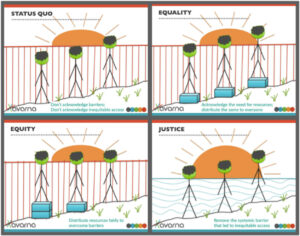
By Prof. Dr. Eugene Allevato
Woodbury University
In education, equity means to ensure that every student has an equal chance for success based on their specific needs. Due to the recent pandemic, the transition to distance learning has caused the achievement gap to widen requiring new tools and strategies to reduce barriers, especially to underrepresented groups. Think aloud is a strategy that enhances student’s comprehension and intellectual growth by removing these barriers. By expressing one’s thoughts while reading, students develop their reading skills because they can acquire information from what they read, add to their knowledge, enlarge their way of thinking and reasoning to advance toward academic excellence. In addition, this strategy provides a better way to assess students’ learning.
Before the pandemic, considering that social interaction is fundamental in the learning process, I was not in favor of online instruction because I thought that physical proximity was necessary for engagement and learning. Once I was forced to transition to virtual instruction and adapt to new technology and different tools, I realized the significance of online instruction. In fact, distance learning implementation, has the potential to cause disengagement and disconnect between teachers and students, due to the perceived lack of communication, physical contact, socio-economic inequity and the technology challenges. According to Northwest Evaluation Association (NWEA), more than 4.4 million students in grades 3-8 performed 5 to 10 percentile points lower in math for the fall 2020 school year, compared to their peers in fall 2019. In addition, researchers at NWEA believe that they may be underestimating the results for underrepresented and disadvantaged groups. On the other hand, if distance learning instruction is properly designed, online activities may encourage participation and peer-to-peer collaboration, depending on the instruction model and utilization of various forms of online resources. According to Garrison and Archer’s Handbook of distance education, students learn better and are more satisfied in online courses with consistent social, teaching, and cognitive presence, independent of the instruction delivery. The think aloud strategy explores all three dimensions and develops critical and reflective thinking.
The dynamics between a teacher and a student are due for update. Instead of only being a fountain of knowledge teachers should also act as a coach, leading students to become critical thinkers and self-learners. The learning experience is earned by the beholder, by their own discoveries, reflections, mental exercises, critical thinking analysis, not from somebody else’s activity. Students need to confront reality through their own critical lens in a student-centered instruction model. Creating an environment of community inquiry to enhance understanding, requires teachers and students alike to immerge in an ocean of uncertainties and discoveries. It requires continuous brain power, creativity, and imagination.
The think aloud process allows for such an opportunity for faculty and students. The moment that students communicate and express their ideas and thoughts, a feedback loop is established. By possessing the tools necessary for a higher level of cognitive learning, students will develop the ability to interpret, analyze and synthesize the knowledge acquired. It is this transformed educational approach that we will see equity departing from just a slogan to a reality.
The think aloud process
The think aloud activity involves two students who take on two roles, reader and listener, working in a collaborative manner to better understand the content of a text. As a reader, one not only reads aloud but also subsequently expresses thoughts, asks questions, and makes connections from past experiences. The listener scrutinizes each word, sentence, and tries their best to understand the statements being heard. Both are contributing to shared growth and enhanced comprehension of the text.
The think aloud activity develops a set of abilities for students to examine their own thinking and that of others by communicating and making judgments based on reasoning. Reasoning requires students to be active and willing to investigate, question, and challenge their own thoughts and assumptions. The information is not absorbed at face value, but rather reflected through observation, and past experience give students the opportunities for analysis and critique. As this process is mastered, the goal is for students to ingrain this new way of reading and understanding, as a form of habitus, and eventually students will become independent learners.
Ways in which think aloud brings equity to the classroom
Think aloud provides students the skills to become self-learners, teach strategies of deciphering the unknown, or the art of argumentative discourse to gain understanding and awareness of something. This requires a paradigm shift from the traditional instruction considering students’ minds as dispensers of information, with confounding passivity, but active learners climbing a scaffold to create paths of acquiring and using knowledge.
We are wired to connect and learn from each other. Paulo Freire in his book, Pedagogy of the Oppressed, examines the issue of equity in education, claiming that the more students work at storing content in a passive role, the less they develop the critical consciousness and act as transformers of the world. Both Paulo Freire and Vygotsky emphasize the social aspect in learning. According to Vygotsky, the learning process is a result of a sociocultural interaction between the learner and the social environment, including teachers, parents and friends. A common theme is the reciprocity between teaching and learning, as we cannot do one without the other. John Dewey emphasized that students learn best if they take a more active role instead of passive learning. The presence of other persons is important because a person learns from the knowledge gained by others.
A think aloud activity allows students to apply critical, metacognitive, and reflective thinking about the content, enhancing their awareness. Therefore, they are improving their approach to learning in a transformative manner, assessing their experiences, receiving, and acting on feedback and setting goals individually, as well as collaboratively, as a result of social presence. The academic growth is shared by knowledge, but most importantly, the path to acquire knowledge. Students become independent learners and socially engaged in a more equitable and inclusive manner.

Image Credit: The Avarna Group’s variation on the classic equity vs. equality image
Figure 1 – Symbolic Description of equality versus equity
In figure 1, we can see a description of the difference between equality and equity. The status quo reflects diversity in the classroom of students with different levels due to background, academic knowledge, and abilities. This imposes challenges for the teacher trying to provide a fair chance for every student to progress. However, all students independent of their abilities and backgrounds deserve a high-quality education and for that an effective instructional model is fundamental. Despite, the existing gap today, schools could serve as the great equalizer. Equality by itself as observed in figure 1 is not effective because students have different levels, and it may be a waste of resources if provided to students that do not need them. In addition, providing equal amount of support still may leave some students behind. Equity requires personalized support and may still be a difficult task as the teacher has to tailor resources to different students. The last quadrant referred as justice, implies that the barriers to assess of opportunities to growth are removed. This can be accomplished by the think aloud activity because all students will have the opportunity to enhance comprehension, communicate and share knowledge. Comprehension or meaning making is something that happens inside our heads and the think aloud provides an opportunity for teachers to mentor and guide students on their needs. Moreover, by students taking ownership for their learning, it stimulates self-confidence and empowerment. Why this strategy promotes equity? Because skills have no bias to economic status, gender or race. The think aloud activity can serve as an equalizer strategy by removing inequity barriers in academic achievement.
Think aloud implementation and students’ perceptions
The implementation of the think aloud process in my classroom was assessed and monitored to evaluate the effectiveness of the think aloud strategy. I explained the think aloud strategy during the lecture, and provided a document describing the strategy. I created groups of two and asked them to practice and videotape themselves during the process. Once a week they were given a short text to read during class in a breakout room and I told them they will be graded on the technique by the end of the semester. The rubric is based on the utilization of the think aloud strategies including predicting, questioning, visualizing, personal response, clarifying, summarizing, reflecting and making connections. Evaluation is not only based on the appropriate utilization of the strategies but also in the accuracy of the content described in the text. The think aloud strategy gives students the opportunity to explain the content and connect with the real world based on previous knowledge and experience. I believe this is a better assessment tool than a final exam.
The challenge is that some students did well, while others did not seem to accept the strategy because of a fixed negative mindset towards group activities and would prefer to work solo. Another reason may be that some students perceive reading aloud as a frightening and embarrassing experience. Moreover, it is frustrating to find that students are not working in the breakout rooms. I found some of them with the microphone off and I assumed they were reading by themselves. In this instance, I asked if they understood the content, and clearly they didn’t. Purposefully, I selected new and difficult topics to create a need for them to collaborate.
One promising finding from a student survey, at the end of the course, was that students already familiar with the think aloud activities were able to implement the strategies better, while students that had never been exposed to the concept of think aloud, understood the benefits of implementing the think aloud strategies even though had difficulties at the beginning.
We cannot deny that learning is a complex phenomenon and impossible to have one solution that fits all. But pedagogy is an experimental science based on research and learning that shows how students respond best. My next goal to improve the implementation of the think aloud strategy is to work on changing students’ negative attitude towards group activities. Here’s what my students say about think aloud:
“I believe that the think-aloud strategy is a very unusual one. I have never tried before, and I was surprised at how I good feel about it. I believe that I learn more by thinking aloud because I questioned my thoughts, I was reading, and clearing my mind of doubts”.
“Thinking aloud strategy is helpful. I think it gives me an opportunity to learn how to read and think at the same time. Although it can be stressful because it feels like someone is judging while you’re reading even though that isn’t the case it’s just my mind telling me that. But once I overcome that it becomes a learning experience, thinking aloud has shown me to slow down my reading and try to understand what I am reading other than trying to have a race in my head with how I am reading. This strategy I feel like is helpful even if you are doing it alone. Reading aloud and making connections with myself still gave me the same outcome of reading with a partner. This tool can be used in classes like writing, math, science, and history”.
“This was my first time ever hearing of and doing the thinking aloud process. For me some of the pros were that for one I was able to have a better understanding of what I was reading and not just reading words on a page. Another positive aspect is that it really did help with my reading comprehension. I will be using this tool in the future whether it’s for a math class or any other class. At first when this new strategy was brought up I was a little confused on the exact steps that I was supposed to be taking in order to make sure that I was doing it right, but other than that I can’t think of anything else to add”.
“When you first explained the thinking aloud strategy, I was a little confused at its purpose. After practicing with a partner and having you spectate and give insight I felt I had a better understanding about the process. I still felt that the extent to which we discuss every sentence individually was excessive. I think that reading a single sentence then discussing that sentence’s meaning is sometimes unnecessary. I admit that some sentences are significant, but not all of them. Some are simply filler and don’t have much information. Maybe analyzing every 3 sentences would be more efficient. However, after using the strategy a few times I felt that at times it was helpful”.
The transition to online learning can be challenging and forced teachers to search for strategies to engage and enhance communication between students to compensate for the lack of face-to-face social interaction. If teachers have an insight of the students’ mind, the instruction process becomes personalized and potentially a powerful equity strategy. The think aloud process promotes the transparency of students’ thoughts and previous knowledge in a context of critical thinking competency, debate, sharing ideas, and community building. This process permits students to grasp a level of literacy and self-learning mindset that allows them to develop awareness and express their voices in the struggle for equity and against injustice.
I tried to implement the think aloud strategy, because I believe this is a very important skill for my students to learn to become independent learners. Throughout the semester, I constantly asked students for their perceptions in writing, and also asked them to record themselves, so I could evaluate whether they were, in fact, utilizing the strategy properly and learning the content. The first challenge was to get students to talk through their thinking process. They are not accustomed to this, and like any cultural change, there were resistance. However, the benefits are numerous, because getting students to speak their thoughts is engaging and boosts their achievement. Based on my findings, it seems that the more often strategies like think aloud are utilized across different disciplines, ranging from science to humanities, the more students will benefit and appreciate it as a process to enhance their comprehension.
References
Bourdieu, Pierre. Distinction: A social critique of the judgement of taste. Harvard University Press, 1984.
Dewey, John. “Democracy in education.” The elementary school teacher 4.4 (1903): 193-204.
Freire, Paulo. Pedagogy of the oppressed. Bloomsbury publishing USA, 2018.
Garrison, D. Randy, and Walter Archer. “A community of inquiry framework for online learning.” Handbook of distance education. New York: Erlbaum (2003).
Kuhfeld, Megan, et al. “Learning during COVID-19: Initial findings on students’ reading and math achievement and growth.” NWEA, November (2020).
Mann, Horace. The republic and the school: the education of free men. No. 1. Teachers College, Columbia University, 1957.
Vygotsky, L. S., “Thinking and speech”. In R.W. Rieber & A.S. Carton (Eds.), The collected works of L.S. Vygotsky, Volume 1: Problems of general psychology. New York: Plenum Press. (1987) pp.39-285
 Dr. Eugene Allevato is a participating Adjunct Faculty, since 2003 at Woodbury University. Dr. Allevato received his Ph.D. in Behavioral Sciences from Tilburg University, in The Netherlands. and his doctoral thesis entailed attitudes toward sustainable development. Eugene has introduced inter-classroom collaborations across two different courses and community service engagement, based on group projects involving students’ majors as a motivational tool. These activities create a classroom environment without walls utilizing experiential learning with hands-on real-world problems by using learning communities and sharing knowledge to promote study skills, self-confidence to reduce students’ learning anxieties. He has published more than twenty scientific publications and has been invited to present his work in national and international conferences.
Dr. Eugene Allevato is a participating Adjunct Faculty, since 2003 at Woodbury University. Dr. Allevato received his Ph.D. in Behavioral Sciences from Tilburg University, in The Netherlands. and his doctoral thesis entailed attitudes toward sustainable development. Eugene has introduced inter-classroom collaborations across two different courses and community service engagement, based on group projects involving students’ majors as a motivational tool. These activities create a classroom environment without walls utilizing experiential learning with hands-on real-world problems by using learning communities and sharing knowledge to promote study skills, self-confidence to reduce students’ learning anxieties. He has published more than twenty scientific publications and has been invited to present his work in national and international conferences.

